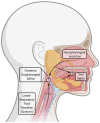Saliva as an alternative specimen to nasopharyngeal swabs for COVID-19 diagnosis: Review
- PMID: 36003360
- PMCID: PMC9394527
- DOI: 10.1099/acmi.0.000366
Saliva as an alternative specimen to nasopharyngeal swabs for COVID-19 diagnosis: Review
Abstract
Almost 2 years ago, the novel coronavirus, severe acute respiratory syndrome coronavirus 2 (SARS-CoV-2) was discovered to be the causative agent of the disease COVID-19. Subsequently, SARS-CoV-2 has spread across the world infecting millions of people, resulting in the ongoing COVID-19 pandemic. The current 'gold standard' for COVID-19 diagnosis involves obtaining a nasopharyngeal swab (NPS) from the patient and testing for the presence of SARS-CoV-2 RNA in the specimen using real-time reverse transcription PCR (RT-qPCR). However, obtaining a NPS specimen is an uncomfortable and invasive procedure for the patient and is limited in its applicability to mass testing. Interest in saliva as an alternative diagnostic specimen is of increasing global research interest due to its malleability to mass testing, greater patient acceptability and overall ease of specimen collection. However, the current literature surrounding the sensitivity of saliva compared to NPS is conflicting. The aim of this review was to analyse the recent literature to assess the viability of saliva in COVID-19 diagnosis. We hypothesize that the discrepancies in the current literature are likely due to the variations in the saliva collection and processing protocols used between studies. The universal adaptation of an optimised protocol could alleviate these discrepancies and see saliva specimens be as sensitive, if not more, than NPS for COVID-19 diagnosis. Whilst saliva specimens are more complimentary to mass-testing, with the possibility of samples being collected from home, the RT-qPCR diagnostic process remains to be the rate-limiting step and therefore interest in salivary rapid antigen tests, which negate the wait-times of RT-qPCR with results available within 15-30 min, may be an answer to this.
Keywords: COVID-19; Nasopharyngeal swabs; SARS-CoV-2; Saliva; diagnosis.
© 2022 The Authors.
Conflict of interest statement
The authors declare that there are no conflicts of interest.
Figures


Similar articles
-
Diagnostic Performance of Self-Collected Saliva Versus Nasopharyngeal Swab for the Molecular Detection of SARS-CoV-2 in the Clinical Setting.Microbiol Spectr. 2021 Dec 22;9(3):e0046821. doi: 10.1128/Spectrum.00468-21. Epub 2021 Nov 3. Microbiol Spectr. 2021. PMID: 34730436 Free PMC article.
-
Detection of SARS-CoV-2 Infection in Gargle, Spit, and Sputum Specimens.Microbiol Spectr. 2021 Sep 3;9(1):e0003521. doi: 10.1128/Spectrum.00035-21. Epub 2021 Aug 25. Microbiol Spectr. 2021. PMID: 34431686 Free PMC article.
-
Buccal swabs as non-invasive specimens for detection of severe acute respiratory syndrome coronavirus-2.J Int Med Res. 2021 May;49(5):3000605211016996. doi: 10.1177/03000605211016996. J Int Med Res. 2021. PMID: 34027696 Free PMC article.
-
Different Respiratory Samples for COVID-19 Detection by Standard and Direct Quantitative RT-PCR: A Literature Review.Iran J Pharm Res. 2021 Summer;20(3):285-299. doi: 10.22037/ijpr.2021.115458.15383. Iran J Pharm Res. 2021. PMID: 34903989 Free PMC article. Review.
-
Salivary SARS-CoV-2 RNA for diagnosis of COVID-19 patients: a systematic revisew and meta-analysis of diagnostic accuracy.Jpn Dent Sci Rev. 2023 Jun 21;59:219-38. doi: 10.1016/j.jdsr.2023.06.004. Online ahead of print. Jpn Dent Sci Rev. 2023. PMID: 37360001 Free PMC article. Review.
Cited by
-
Saliva as alternative to naso-oropharyngeal swab for SARS-CoV-2 detection by RT-qPCR: a multicenter cross-sectional diagnostic validation study.Sci Rep. 2022 Jul 23;12(1):12612. doi: 10.1038/s41598-022-16849-1. Sci Rep. 2022. PMID: 35871257 Free PMC article.
-
Oral manifestations of COVID-19 in unvaccinated patients: a cross-sectional study.BMC Oral Health. 2023 Sep 27;23(1):696. doi: 10.1186/s12903-023-03325-z. BMC Oral Health. 2023. PMID: 37759210 Free PMC article.
-
Kinetics of SARS-CoV-2 infection biomarkers in a household transmission study.Sci Rep. 2024 May 29;14(1):12365. doi: 10.1038/s41598-024-62835-0. Sci Rep. 2024. PMID: 38811590 Free PMC article.
-
Saliva as a Biological Fluid in SARS-CoV-2 Detection.Diagnostics (Basel). 2024 Apr 29;14(9):922. doi: 10.3390/diagnostics14090922. Diagnostics (Basel). 2024. PMID: 38732336 Free PMC article.
-
Rapid RT-PCR identification of SARS-CoV-2 in screening donors of fecal microbiota transplantation.Heliyon. 2023 Jun;9(6):e17438. doi: 10.1016/j.heliyon.2023.e17438. Epub 2023 Jun 18. Heliyon. 2023. PMID: 37366528 Free PMC article.
References
-
- Centers for Disease Control and Prevention Emerging SARS-CoV-2 Variants. 2021. https://www.cdc.gov/coronavirus/2019-ncov/more/science-and-research/scie... - PubMed
-
- Our World in Data Coronavirus (COVID-19) Vaccinations. 2021. https://ourworldindata.org/covid-vaccinations
-
- World Health Organization Laboratory testing for 2019 novel coronavirus (2019-nCoV) in suspected human cases. 2021. https://www.who.int/publications/i/item/10665-331501
Publication types
LinkOut - more resources
Full Text Sources
Miscellaneous
